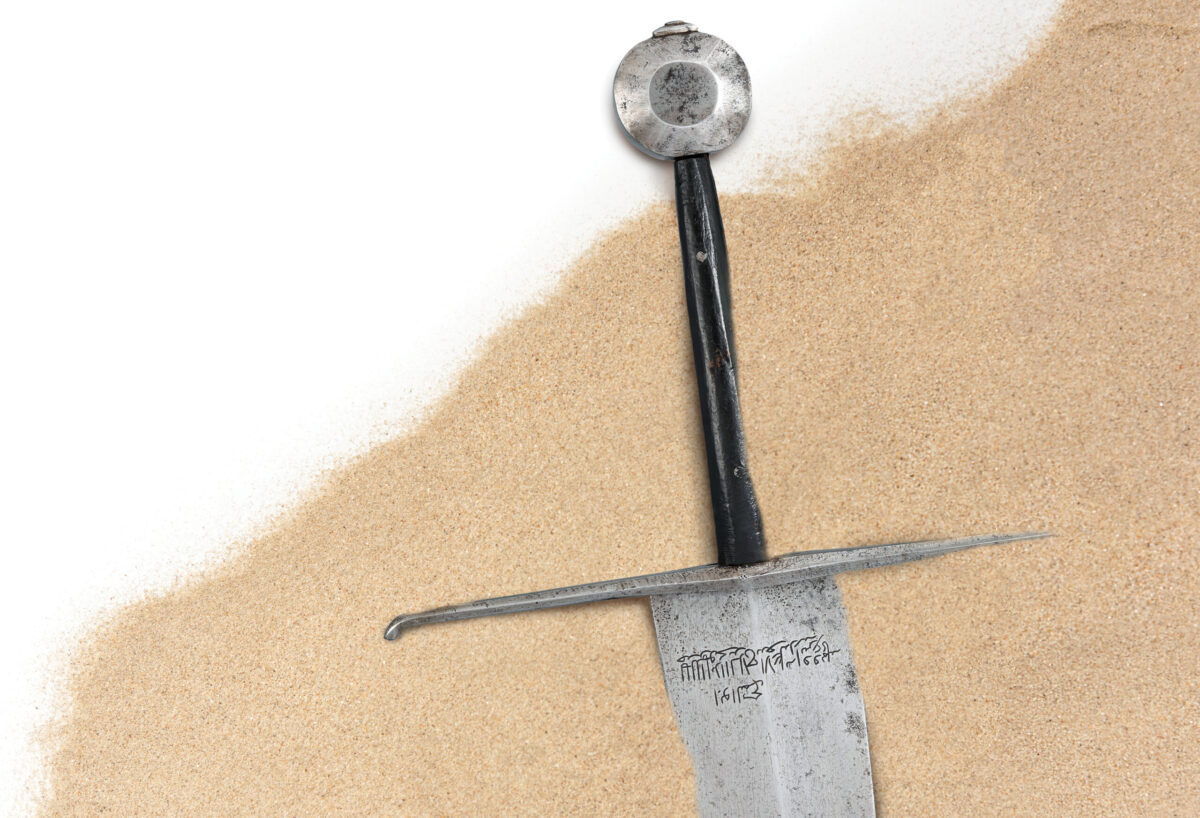Salah al-Din Yusuf ibn Ayyub, Muslim Sultan of Egypt and Syria, known to the west as Saladin, is certainly one of the most durably famous historical figures from the period of the Crusades. His political and military skills won him the admiration of the Muslim world. Unifying the forces of Islam, he struck the heaviest blows against the Crusader kingdoms, shattering a massive Christian army at Hattin and wresting Jerusalem from their control in 1187.
But he is also remarkable as an historical rarity—a champion on one side of a bitter contest who was also admired by his opponents. His ferocity in battle and generosity to his enemies secured him a great reputation in Europe as a chivalrous knight, an esteem that has largely endured in the Western mind.
Saladin was born in the city of Tikrit in 1137, emerging into a world rife with divisions, both political and religious. Part of Saladin’s durability in historical memory can be attributed to the similarities between his world and our own, for some of the same divisions still fester. The Muslim world is still divided by the fundamental Sunni-Shia schism and a multiplicity of sects quarreling about both theological and worldly matters. Pope Urban II had issued the call for the First Crusade some 40 years before Saladin was born, and the arrival of Christian armies created the fundamental division that would shape his world. The First Crusade (1096-1099) captured Jerusalem and saw the creation of Christian states along the coast of Palestine. As resilient as they were, they remained outposts requiring continual support from Europe to be maintained.
They also clearly benefitted from the disunity of Muslim rule and the lack of unified a military opposition. After their initial success, the task of the crusaders became defensive—to hold what they had won. Saladin was to be their greatest challenge.
The Making of A Leader
Little is known about Saladin’s early years other than the lingering reputation of a studious and thoughtful nature tending to greater zeal for religious than military training. He was well-placed for advancement. His father, Ayyub, was Governor of Damascus, and his uncle, Shirkuh, commanded the armies of Nur-al-Din, the ruler of Syria. Positioned for close observation, Saladin conceived a great admiration for Nur-al-Din’s piety and capable rule and, in later years, would draw inspiration from his ambition to unite the Muslim peoples between the Nile and the Euphrates to create a united front against the Crusaders. But Saladin was not yet a warrior. In the wake of the Second Crusade’s (1145-1149) attempt upon Damascus, Nur-al-Din sought to stir up martial fervor among his people and asked for volunteers in the Holy War. Saladin did not respond.
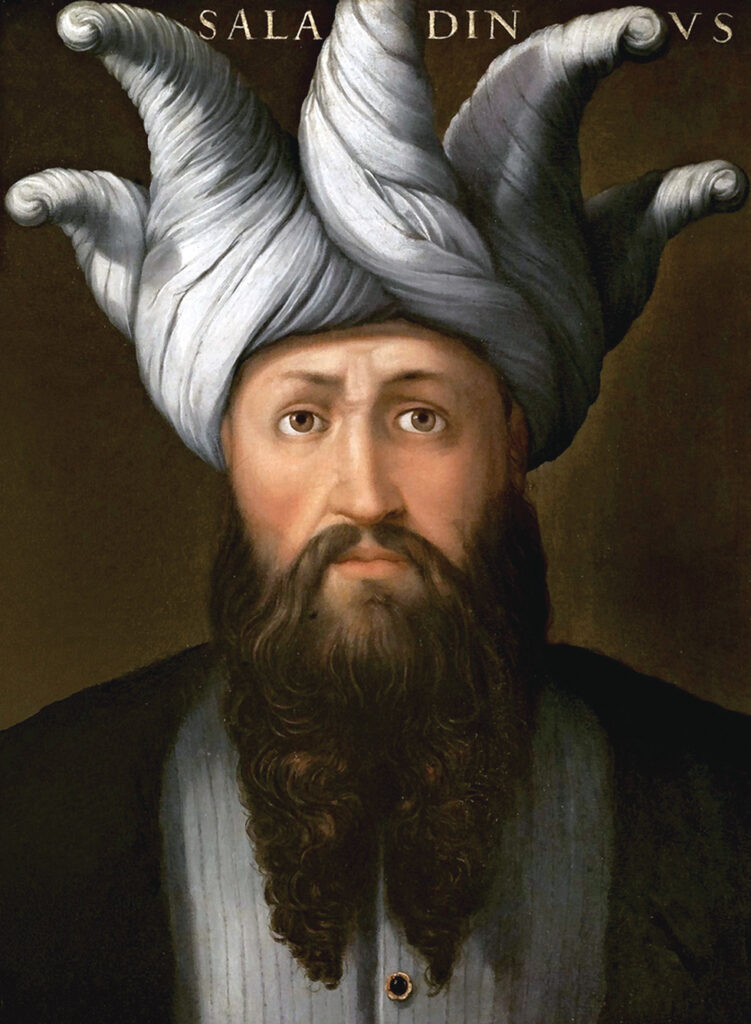
Saladin’s formal career began when he joined the staff of his uncle, Shirkuh, accompanying him on an expedition to Egypt, which would lay the foundations of his future success. In 1163, Shawar, the deposed Vizier of Egypt, appeared in Damascus promising one-third of the revenues of Egypt for Nur-Al-Din’s aid in restoring him. Though in theory subject to the Caliph, a vizier of Egypt was virtually a king. The potential benefits of intervening on his behalf were too good to pass by. Shirkuh was dispatched with an army, and he took a reluctant Saladin with him.
In the background lay complex rivalries between Muslims and Christians, and among Muslims themselves. While Syria recognized the religious authority of the Abbasid caliph of Baghdad, Egypt walked a different path. The origins of the split lay early in the history of Islam. In 655, the succession to the religious and political authority of the caliphate was contested over a dispute as to whether the leader of Islam must be a direct descendant of the Prophet. This view was advocated by Ali, who had married Muhammad’s daughter Fatima. Ali and Fatima lost the contest, but their supporters maintained their allegiance to their various descendants, giving rise to a distinctive form of Islam called Shi’ism—in contrast with the majority of Muslims, the Sunnis. In the tenth century, the Shi’ites established the Fatimid dynasty of caliphs in Cairo. To the orthodox Nur-al-Din, the heretical Egyptians were almost as contemptible as the infidels. But this distaste was tempered by the realization if the Christian Franks were able to dominate Egypt, Syria would be ruined and Islam seriously imperiled.
To Egypt
But by the time the expedition had reached Egypt, the Vizier had recovered his office and had no use for Shirkuh’s army. He refused to pay them. When Shirkuh showed no inclination to leave without his compensation, Shawar appealed to Amalric, King of Jerusalem for aid. A complex three-way struggle then ensued in which Saladin gained valuable military experience. When the dust had settled, the Christians had been expelled, Shawar was dead, Shirkuh was the Vizier of Egypt—and Saladin was his executive officer. How precisely Shirkuh would have navigated the politically and religiously awkward position he now inhabited is not clear. Three months later he was dead, and the Fatimid caliph appointed Saladin as his successor.
Saladin now inhabited a position of power, but it was beset with difficulties. He was bound to three masters and two versions of Islam. He owed allegiance to Nur-Al-Din in Damascus, and through him the Sunni caliph in Baghdad, as well as Egypt’s Shia Fatimid Caliph. In addition, the quick, successive shifts in power had left Egypt unstable. Unhappy with the new regime, various groups plotted against Saladin, and internal divisions invited challenges from the Byzantines and the Crusaders. Saladin navigated the difficulties with great skill, gaining firm administrative and military control of the country while strengthening his army and navy. But his very successes caused problems of his own, for the stronger he became, the more Nur-al-Din worried about the reach of his ambitions.
In 1171, at the risk of rebellion, Saladin deposed the Fatimid caliph in favor of the Abbasid caliph of Baghdad. Two days later Cairo’s caliph died, and Saladin was the master of Egypt. While Egypt’s return to orthodoxy pleased Nur-al-Din, Saladin’s increasingly successful empire building did not. Tensions between the two men continued to rise.
When Nur-al-Din died in 1174, Saladin was not only relieved of the burdens of a jealous superior, but the power vacuum in Syria also presented him with an opportunity for expansion. By this time Saladin was a determined holy warrior, but he knew he would first have to unite the Muslims as a foundation for war against the crusaders. Long years of struggle lay before him, but he captured Damascus, Aleppo, and Mosul from other Muslim rulers.
Facing the Crusaders
In May 1180, Saladin signed a treaty with Baldwin IV, who had become King of Jerusalem in 1174 at 13 years of age when his father, Amalric died. It made sense. After a period of draining and indecisive clashes, both sides were suffering from internal disorders that made a respite of peace agreeable. But the underlying conflict remained, as did the militant purposes of both sides, and provocations wore away at the agreement. One provocateur, Renaud de Châtillon, did more than any other to erode the peace.
The relentless raids he launched on Muslim caravans from his impregnable castle, Kerak of Moab, incited Saladin’s rage. He appealed to Baldwin, but the king, suffering from leprosy, did not have the strength to restrain the firebrand. Hostilities were renewed. Saladin took Aleppo in 1183 and besieged Kerak. The Kingdom of Jerusalem, weakened by a faltering king, internal quarrels, and a disputed succession felt the weight of Saladin’s growing power.
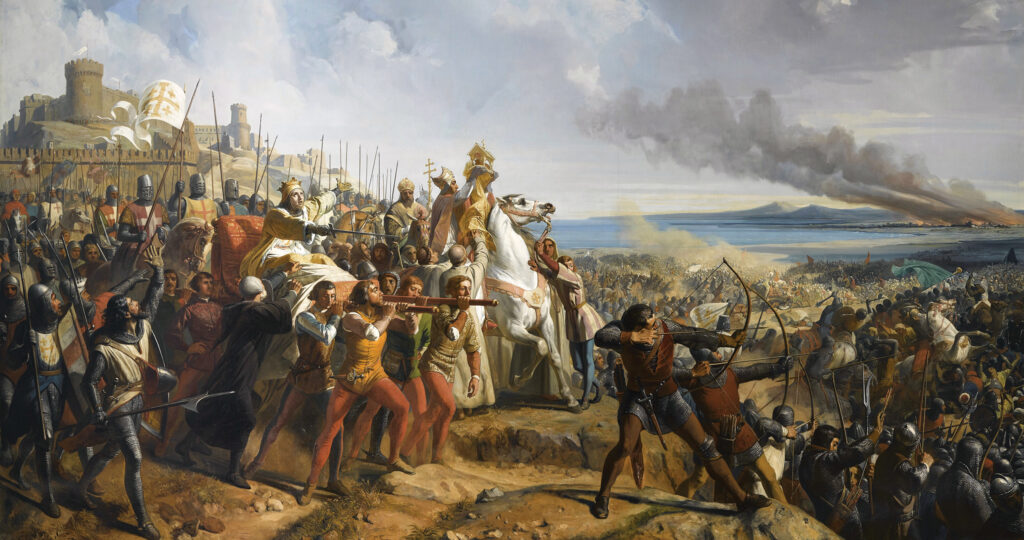
By 1186, Saladin had united the Muslim territories of Syria, northern Mesopotamia, Palestine and Egypt under his rule. Saladin’s dedication to jihad and singleness of purpose were in sharp contrast to the dissensions and rivalry that had hampered Muslim resistance to the Crusaders in the past. Saladin had forged a powerful weapon, and he was ready to wield it. In that same year, Guy de Lusignan, a man unsuited by temperament or skill to clash with Saladin, became King of Jerusalem. As the Crusaders faced their greatest threat, they were led by an improvident adventurer whose only claim to power lay in his marriage to Baldwin’s sister. Plagued by divided counsels and self-seeking ambition, they would soon pay a terrible price.
Having gathered a massive army of 30,000 troops, Saladin invaded Galilee and besieged the city of Tiberias, baiting a snare he hoped would lure the enemy onto ground of his choosing. Guy mustered his own army around Saphorie, fielding around 20,000 infantry and 2,000 knights, half of whom were members of the famous religious orders, Knights Templar and Hospitallers. Count Raymond III of Tripoli, whose own wife and children were confined within the city, counseled Guy not to march.
The Horns of Hattin
Between their position and Tiberias stretched an arid plain, sizzling in the July heat, where they would find little or no water. In such conditions, Saladin’s lightly armed cavalry would have the advantage, and he prophesied the destruction of the army if they walked into Saladin’s trap. But Guy was swayed by others, Renaud and Gérard de Ridefort, Master of the Templars, whose violent aggression was impervious to prudence.
Leaving at dawn, the army marched across the plain in the sweltering heat up into the hills on the western shores of the Sea of Galilee. With no water-carts, the leather bottles they carried were fast depleted. The hot sun fell upon them like a hammer upon an anvil, and the knights sweltered in their armor. The miseries of the march were compounded by harassment by the enemy, who loosed clouds of arrows upon them before racing away far too swiftly for the weary and parched crusaders to respond. These tactics combined with attacks on the rear guard, only prolonged the miseries of the hellish march.
Exhausted, the army camped just below an outcrop above the Sea of Galilee, known as the Horns of Hattin. It was bad ground, a dried-up lava flow from an extinct volcano strewn with black basalt rocks hidden beneath scrub grass, dangerous to horses. They would spend a miserable night tormented by thirst, an experience made worse by the glimmering fresh water of the lake beneath them. But the way was barred by the stretching encampment of Saladin’s army.
With the morning of July 4, 1187, the Christian army would try to carve its way to the lake. But Saladin had advanced his men during the night, and they now set fire to the dry grass, sending choking clouds of smoke into the crusader camp. Maddened by thirst, the foot soldiers rushed ahead blindly, only to be thrown back. The knights charged, wheeled, charged again, but they could not pierce the Muslim lines. All that day the battle raged, the crusaders finding reserves of strength that impressed even their enemy. But to no avail. Raymond III of Tripoli did finally succeed in breaking through with some of his heavily-armored knights and, escaping the battlefield, proceeded to Tripoli. His withdrawal had been approved by the king, lest none survive to fight future battles. The next day, the remaining crusaders made a last stand, but, with the remnants of the Christian army strewn about the hills, exhaustion compelled the handful of survivors to surrender.
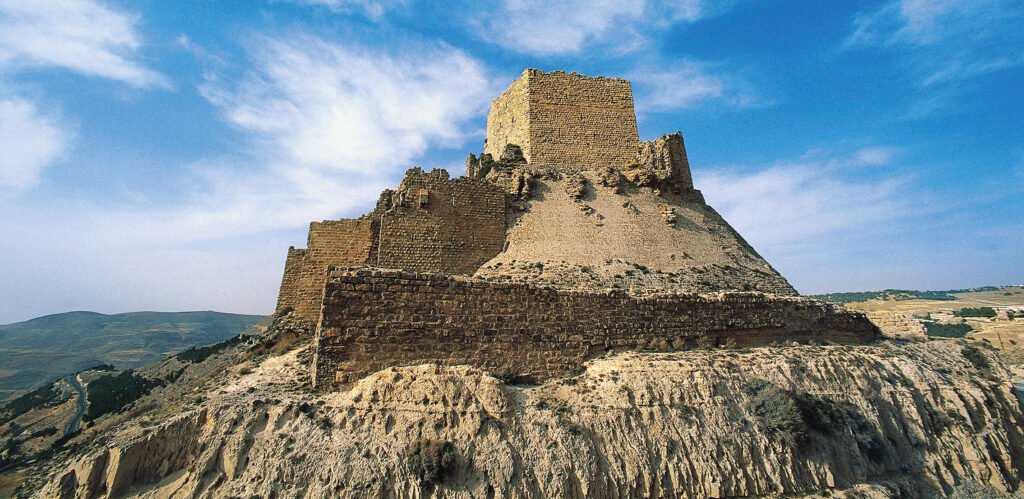
The concept of chivalry involves a combination of fierceness and gentleness that can be difficult to grasp in theory, much less to achieve and maintain in practice. Saladin was to have a chivalrous reputation in the Christian West, but there was little gentleness toward the Christians he defeated at Hattin. The surviving infantrymen were all sold into slavery. Saladin killed Renaud with his own hands, as he had sworn to do, and had his head impaled on a lance as an ornament to embellish his triumphant return to Damascus. The remaining knights were executed by the mullahs and religious teachers accompanying his army. He also sent an order to Damascus condemning all of the knights held captive there to immediate death.
On the other hand, he did show compassion when he did not have to, offering the countess of Tripoli safe-passage with all her people and possessions to rejoin her husband and paroling Balian of Ibelin to return to Jerusalem to look after his wife, a former queen of Jerusalem. He spared Guy along with a handful of others, imprisoning them in Damascus. The medieval mind was not overly troubled by such stark contrasts, and many a Christian knight was deemed chivalrous who did not do as well.
Securing the Coast
Desirous that his great victory at Hattin be used to its greatest potential, Saladin moved to secure the coast of Palestine against future incursions and isolate the inland castles. He moved first upon Acre which, inadequately defended, surrendered. From there his forces marched along the coast, as well as through Galilee and Samaria. Christian strongholds rapidly tumbled into his hands through surrender or after brief sieges. After Hattin, they had no strength to resist. Saladin displayed much of his customary mercy and forbearance with the conquered. By September, only Jerusalem and Tyre remained in Christian hands.
Tyre, with admirable defenses and under the command of the newly-arrived Conrad of Montferrat, a man of great ability and determination, held out against assault. Saladin left it unconquered. Strategically, this was a mistake, as it left his enemies a crucial foothold on the coast and a beachhead for another invasion. Even some contemporary Muslim commentators, while praising his many admirable qualities and achievements, reproached him for underestimating the danger. Nonetheless, leaving the prospect of months of grueling siege behind him, Saladin turned toward Jerusalem. The struggle for the Holy City was the source of the crusading movement and its possession the ultimate prize. Now, it lay within his grasp.
Balian of Ibelin took command of the Christian forces, such as they were, defending Jerusalem. As a prisoner on parole after Hattin, he wrote to Saladin, apologizing and asking him to spare the city. Saladin forgave Balian but would not give up Jerusalem. Balian had little to work with. While the city was strongly fortified, it was swollen with refugees, with one man to every 50 women and children, and had only 14 knights. Nonetheless, Balian girded for battle. He knighted every boy of noble descent and 30 common citizens. He seized all the treasure he could find, including silver from the Church of the Holy Sepulchre, hastily brought in provisions from the surrounding villages, shut the gates, and prepared to endure the storm.
Arriving on Sept. 20, Saladin’s siege engines bombarded the Tower of David and the surrounding walls for five days. Failing to make much of an impression on the fortifications, he then shifted northeast to the Mount of Olives, the location from which the Crusaders had launched their attack nearly a century before. While 40 mangonels battered the walls, torrents of arrows swept them clean of defenders, and sappers worked to undermine their foundations. After three days, the masonry crumbled, opening a breach. The city was doomed.
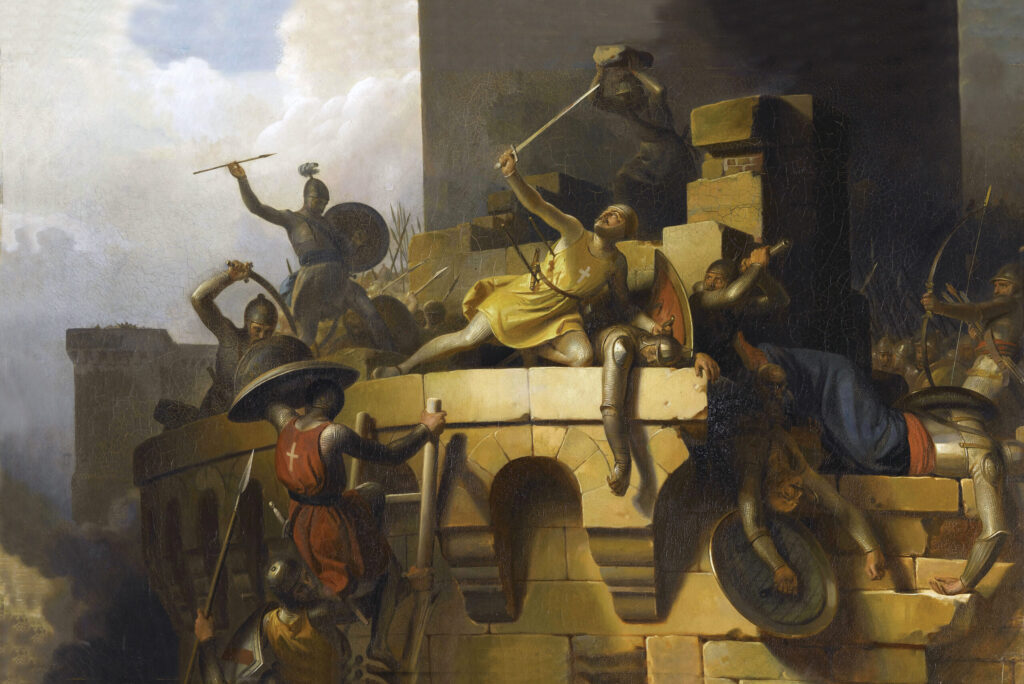
Officials from the city came to negotiate terms. But, remembering the bloodshed when the Christians took Jerusalem in 1099, Saladin would not negotiate. He had sworn he would take the city by the sword. On Sept. 30, Balian himself appeared in Saladin’s tent. He knew there was no chance of holding the city, but he presented Saladin with an apocalyptic vision: the Muslims would have the city, but it would be a city of ash. As a last resort he would set Jerusalem on fire, demolish all the holy places including the Dome of the Rock and the al-Aqsa Mosque, destroy all the treasure, and kill every living thing. He would reduce the Holy City to wreckage, scorched with flame and drowned in blood. His description must have been vivid, for Saladin relented, agreeing to accept ransom: 10 dinars for every man, 5 for every woman, and one for every child.
Richard the Lionheart
The capture of Jerusalem was not the end of Saladin’s struggles. His tremendous success caused the caliph to fear his ambition would reach to overturning the Abbasid dynasty. There were also those who doubted the wisdom of Saladin’s generosity toward the Christians. By allowing them to leave Acre, Ascalon, and Jerusalem, he only strengthened Tyre, fortifying a Christian outpost to be relieved by additional forces from Europe. Word of Jerusalem’s fall reached Europe quickly with appeals for aid. Pope Gregory VIII called for a new crusade. The response was enormous in volunteers and monetary contributions (not always voluntary), called in England the “Saladin Tithe.”
The Third Crusade (1189-1192) would be led by kings: Richard I of England, Philip II of France, and Emperor Frederick I (Barbarossa) of Germany. Great armies mobilized and headed for Palestine. The Christians already there made trouble of their own. Though hampered by division between King Guy, who Saladin had released from prison in 1188 and Conrad of Montferrat, who desired the crown of Jerusalem, the crusaders besieged Acre. A stalemated double siege lasted for two years, with the besiegers themselves hemmed in by Saladin’s army, which was not strong enough to drive them off or destroy them.
In June of 1191, King Richard I of England arrived in the Holy Land. Richard stands out from the pages of history as a glamorous figure: tall, good-looking, fearless, and immensely strong, he was known as Richard Coeur de Lion (the Lionheart). Richard assumed leadership of the crusade after Frederick perished en route and Philip departed for Europe. The strategic duel between the two champions, Richard and Saladin, captured the medieval European imagination and solidified Saladin’s lasting reputation. Though their battle was bitter, they saw each other as worthy opponents.
Richard fell upon the Holy Land like a thunderstroke, but did not have the power to retake Jerusalem. Saladin parried him with both blade and diplomacy. They agreed upon a truce under which the Christians retained the coastal zone from Jaffa to Tyre and were permitted to make pilgrimages to Jerusalem. The Holy City itself remained in Saladin’s hand. Richard departed, disappointed, to deal with troubles at home.
Saladin did not live much longer. He died in March 1193 at 54 years old. He was Islam’s greatest champion, master of the east, bringing an unparalleled unity and wielding a victorious sword, honored by Muslim and Crusader alike. The unity he had forged collapsed after his death. The fame he won lives on.

